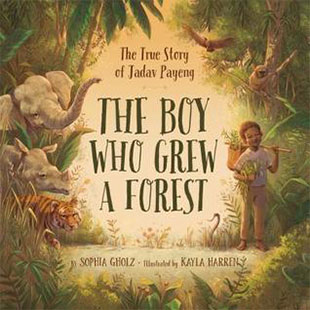"The best time to plant a tree was twenty years ago.
The second best time to plant a tree is now."
This proverb begins the true story of Jadav Payeng, a boy in India's Brahmaputra River region who loves trees for their shade, shelter, and nourishment. Erosion during rainy season is sweeping away all that he loves, though, leaving empty sandbars behind. Aware of life's connections, he knows that if animals wither without trees, so will people.
He approaches the village elders, who encourage him to create new homes for the animals by providing him with twenty bamboo seedlings. In one of Kayla Harren's heartwarming illustrations, we see Jadav strolling thoughtfully through a deforested meadow, the seedlings held tenderly in his arms, while clouds behind him take the form of the grown trees that his imagination already perceives.
He plants the seedlings with hope and determination on a large sandbar, but he doesn't leave them alone. He builds a watering system with dripping pots on stilts and keeps on lugging water even when his back aches. Once he has a healthy thicket, he worries that it won't help enough, and he brings cow dung, earthworms, termites, biting red ants (ouch!), and more seeds from nearby.
So the story continues until we see whole families of elephants, one-horned rhinos, and many other species return to the region as Jadav becomes a man. The challenges then concern eco-system balance: He must provide grasses to attract small animals for the tigers to eat, for instance, so that they won't attack people or livestock. Meanwhile, his trees grow tall as buildings.
Sophia Ghotz loves trees. She should be rightfully proud of the way that The Boy Who Grew a Forest, her debut picture book, will acquaint many 5 - 8 year olds with a forest's marvels — and with their own potential to see a dream through to its fullness. Resources on the last two pages tell us more of Jadav Payeng's story and offer tips about how to plant a forest of your own.
